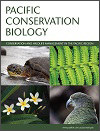South-western Australia’s species are adapted to a predictable climate that is now experiencing increasing temperatures and declining rainfall. Population parameters for most of 29 reptile species, evaluated in situ, are documented to assist in interpreting species performance and predicting persistence under ongoing habitat modification and a varying climate.
PC24016 Abstract | PC24016 Full Text | PC24016PDF (670 KB) | PC24016Supplementary Material (1.1 MB) Open Access Article





